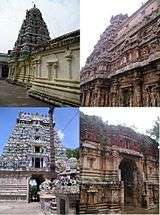Swetha Vinayagar Temple
| Swetha Vinayagar Temple | |
|---|---|
|
| |
 Location in Tamil Nadu | |
| Geography | |
| Coordinates | 10°57′N 79°19′E / 10.950°N 79.317°ECoordinates: 10°57′N 79°19′E / 10.950°N 79.317°E |
| Country | India |
| State | Tamil Nadu |
| District | Thanjavur |
| Locale | Tiruvalajuli (near Swamimalai) |
| Culture | |
| Sanctum | Kabardeeshwarar(Shiva), Vellai Vinayagar(Ganesha) |
| Architecture | |
| Architecture | Dravidian architecture |
The Swetha Vinayagar Temple (Tamil: Vellai Vinayakar Koil) is a Hindu temple situated in the village of Thiruvalanchuzhi (also spelt as Thiruvalanjuli) near Swamimalai in Kumbakonam taluk of Thanjavur district, Tamil Nadu, India. The presiding deity is Kapardiswarar, a form of the Hindu god Shiva and his consort Brihannayaki.[1]
Legends

The temple is associated with a sage called Herandar, who, according to legend, is believed to have gone through an underground passage to the nether world and brought the Kaveri River to the earth to flow into the Bay of Bengal.[1] Since the river took a convoluted direction in its flow, the place is called Tiruvalanjuzhi. There is an image of Herandar in the temple and the trunk of the elephant-headed god, Ganesha (Vinayagar) swirls towards the right.[2] The presence of Buddhist images from the Chola period in the temple show influence of Buddhist tradition in the region.[3]
Vinayaka idol
The temple is renowned for its shrine dedicated to Ganesha (Vinayagar, Vinayaka).[1] The idol of Vinayaka is white in colour and is believed to have been created out of sea sand. Hence, the temple is also known as Swetha Vinayagar Temple in Sanskrit or Vellai Vinayakar Temple in Tamil, meaning "the temple of the white Vinayaka".
According to popular legend, Indra, the king of the Devas created the idol of Ganesha out of sea sand during the churning of the ocean and left it in a niche in the temple hoping to get back the idol sometime later.[1] But later, when he returned to remove the idol of Ganesha, it would not budge. So, the idol was allowed to remain where it was.[1] A lattice-worked stone window pane called palahani is present in the temple.[2] The temple is originally believed to have been built by Kanaka Chola in prehistoric times.[2]
As per another legend, when Devas (celestial deities) and Asuras (demons) were churning the Ocean of milk with Vasuki the serpent, they disregarded the advice of Vinayaka. It resulted in the spilling of poison in Amruta. To propitiate, the Devas created an image of Vinayaga with sea water and worshipped him at the place. The image of the presiding deity is white in colour on account of the belief.[4]
Religious importance
| Saptha Vigraha moorthis are the seven prime consorts in all Shiva temples located at seven cardinal points around the temple | ||
| Deity | Temple | Location |
| Shiva | Mahalingaswamy temple | Tiruvidaimarudur |
| Vinayaga | Vellai Vinayagar Temple | Thiruvalanchuzhi |
| Murugan | Swamimalai Murugan temple | Swamimalai |
| Nataraja | Natarajar temple | Chidambaram |
| Durga | Thenupuriswarar Temple | Patteswaram |
| Guru | Apatsahayesvarar Temple | Alangudi |
| Navagraha | Suryanar Kovil | Suryanar Kovil |
According to a Hindu legend, Mahalingaswamy at Thiruvidaimarudur is the centre of all Shiva temples in the region and the Saptha Vigraha moorthis (seven prime consorts in all Shiva temples) are located at seven cardinal points around the temple, located in various parts of the state.[5][6] The seven deities are Nataraja in Chidambaram Nataraja Temple at Chidambaram, Chandikeswarar temple at Tirucheingalur, Vinayagar in Thiruvalanchuzhi Kabardeeshwarar Temple, Muruga in Swamimalai Murugan Temple at Swamimalai, Bhairava in Sattainathar Temple at Sirkali, Navagraha in Sooriyanar Temple at Suryanar Kovil and Dakshinamoorthy in Apatsahayesvarar Temple, Alangudi at Alangudi, Papanasam taluk.[6]
See also
Notes
- 1 2 3 4 5 P. V. Jagadisa Ayyar (1920). South Indian shrines: illustrated. Madras Times Printing and Pub. Co. pp. 355–359.
- 1 2 3 A. 1987, p. 35
- ↑ Pillai, Suresh B. (1976). Introduction to the Study of Temple Art. Equator and Meridian. p. 59.
- ↑ V., Meena (1974). Temples in South India (1st ed.). Kanniyakumari: Harikumar Arts. p. 27.
- ↑ Tourist guide to Tamil Nadu (2007). Tourist guide to Tamil Nadu. Chennai: T. Krishna Press. p. 53. ISBN 81-7478-177-3.
- 1 2 Narayanaswami (April 1987). "Jyothirmaya Mahalingam". Om Sakthi (in Tamil). Coimbatore: Om Sakthi Publications: 34-5.
References
- A., Kuppuswami (1987), The Crest Jewel of Divine Dravidian Culture, Pudukottai: Sarma's Sanatorium Press .
- Tourist Guide to Tamil Nadu. Sura Books. p. 81. ISBN 978-81-7478-177-2.
External links
| Wikimedia Commons has media related to Swetha Vinayagar Temple. |

